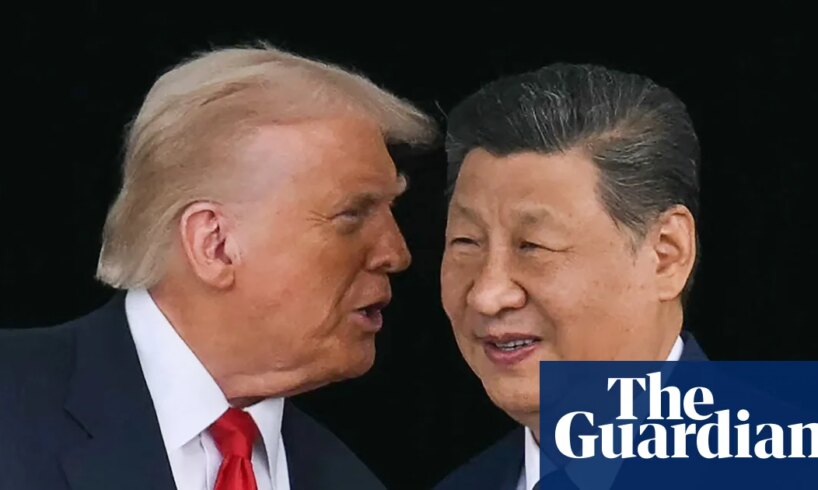
When Donald Trump launched his trade war against China in April, threatening tariffs as high as 145%, the Chinese government said it would never bow to blackmail and vowed to “fight to the end”.
The question now is whether the consensus reached between Trump and Xi Jinping in Busan, South Korea, on Thursday means that the fight really has come to an end, and if so on whose terms.
Trump rated it as a 12 out of 10 meeting.
Both sides have taken some of their biggest guns off the table, but this appears closer to a truce than a durable peace setting stable boundaries for China’s relations with the US. Nevertheless the outline of a broader long-term diplomatic relationship is visible, with announced reciprocal visits by each leader within a year. That is very different to what China hawks in Congress were hoping when Trump came to power, and will set alarm bells off on both sides of the aisle.
One of the difficulties has been that Trump’s strategic objectives in launching the trade war were not articulated – the balance between protecting traditional US manufacturing, ring-fencing modern technology-based industries critical to US national security, punishing Chinese trade practices, or more broadly generally overpowering China as a competitive threat, were fudged. Gradually the battle morphed in some US administration minds from a trade war into a geopolitical trial of strength between the two world’s superpowers, a trial that left the whole world awaiting its outcome.
As a result it has been a turbulent six months, involving undulating tariffs, export curbs, threats, counter-threats, deferral and monopolies inquiries, interspersed with five rounds of trade talks ranging though Madrid, London, Geneva, Stockholm and Kuala Lumpur, culminating in two hours of direct talks between Trump and Xi, the first meeting between the two men since 2019.
Through most of the crisis US tariffs on Chinese goods have averaged 55%. That was well below the effective total embargo level of 145% that Trump once threatened, but still high enough to pose a severe stress test to the resilience of the Chinese economy, a test it has passed.
What emerged from Thursday’s meeting will require time to digest. In reality this is only a framework agreement and, as Canada is discovering, such agreements have the potential to unravel at a moment’s notice. Moreover, in examining trade deals it is normally said the devil lies in the detail, but with a Trump trade deal the devil often lies in the lack of detail.
Much of it amounts to a return to the status quo. China has agreed to defer for at least a year the potentially crippling new restrictions on the export of rare-earth materials. China will once again buy US soya beans. Beijing has agreed to do more to control the export of precursor chemicals used to make fentanyl, the synthetic opioid that has triggered a crisis of overdose deaths in North America, the supposed cause of 20% tariffs. In return Trump has agreed to halve that 20% levy, taking the average of US tariffs down to 45%, still higher than India. He has also suspended expanded restrictions on export controls.
Trump, on the plane home from South Korea, was evasive about the US role in loosening licence applications for shipments of Nvidia’s artificial intelligence chips to China, saying the subject of the new most powerful chip, the Blackwell, did not come up, and it was a matter for China and Nvidia. National security hawks in Washington will be watching.
The terms for the Chinese firm ByteDance’s divestment of TikTok America will be announced separately, including the size of ByteDance’s continuing stake, and control of the algorithm.
On Trump’s account, fears that he was about to abandon Taiwan were also misplaced. The subject did not feature, he said implausibly.
More importantly over the past six months both sides have learned about the other’s leverage and vulnerabilities, including which trade weapons work best. For the US it will be disturbing the extent to which China was able to divert US-bound exports to other mainly Asian markets once the US tariffs struck. Those who predicted China would spill into a crisis will have been sobered by a stock market that has risen by 34% in dollar terms, double the rise for the S&P 500 index. China’s trade surplus is likely to be larger than last year’s. Meanwhile US inflation figures, driven by tariffs, crept up to a politically perilous 3%.
Chinese restrictions on buying US soya beans, a $12bn (£9.1bn) market, were also effective. It sent politically critical US midwest farming interests towards penury as Brazil filled the market gap.
Above all, after a US commerce department rule-change in September, which by some accounts added 10,000 Chinese firms to Washington’s list of sanctioned companies, Beijing massively retaliated by expanding the scope of its export controls on rare earths, the elements essential for hi-tech manufacturing including cars, batteries and military equipment.
If implemented fully, it would give China the ability to restrict the production around the world of all kinds of productsthat depend on only a small trace of rare earths sourced from China. The vast controls, announced on 9 October and due to have come into force in November worldwide, underscored the US failure to shed its supply chain reliance on China’s near monopoly on refining these rare-earth products.
In a laughably hypocritical bid to rally the world against this China “bullying”, Jamieson Greer, America’s trade representative, on 15 October complained: “China’s announcement is nothing more than a global supply-chain power grab.” America discovered that bullies could be bullied back, something it might have foreseen.
By one account, the treasury secretary, Scott Bessant, examining the imminence of the precipice, persuaded Trump that the price of confrontation was proving too high, leading the two sides to the mutual withdrawal this week.
The truce is only for a year, but that may be to China’s advantage. It buys Xi time to push China further ahead in the technologies of the future, including green technology and manufacturing, the field it now dominates, and the centrepiece of the new five-year economic plan.
Equally importantly, China hopes it will be seen by other countries as the responsible and restrained global power not seeking confrontation, but strong enough to withstand US coercion. At a minimum the clash in leadership cultures is total. Xi is an exponent of the war of position, and Trump the war of manoeuvre in which instinct triumphs over consistency or strategy. For the moment the positional warrior is winning, or at least not losing.





